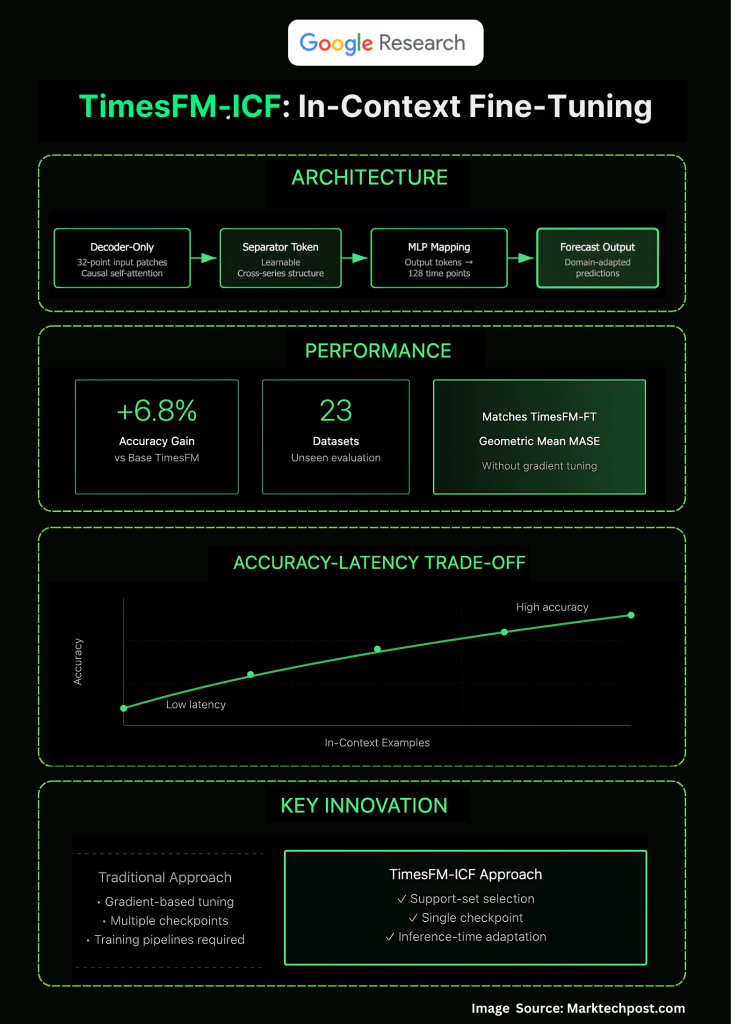Table of contents
Google Research introduces in-context fine-tuning (ICF) for time-series forecasting named as ‘TimesFM-ICF): a continued-pretraining recipe that teaches TimesFM to exploit multiple related series provided directly in the prompt at inference time. The result is a few-shot forecaster that matches supervised fine-tuning while delivering +6.8% accuracy over the base TimesFM across an OOD benchmark—no per-dataset training loop required.
What pain point in forecasting is being eliminated?
Most production workflows still trade off between (a) one model per dataset via supervised fine-tuning (accuracy, but heavy MLOps) and (b) zero-shot foundation models (simple, but not domain-adapted). Google’s new approach keeps a single pre-trained TimesFM checkpoint but lets it adapt on the fly using a handful of in-context examples from related series during inference, avoiding per-tenant training pipelines.
How does in-context fine-tuning work under the hood?
Start with TimesFM—a patched, decoder-only transformer that tokenizes 32-point input patches and de-tokenizes 128-point outputs via a shared MLP—and continue pre-training it on sequences that interleave the target history with multiple “support” series. Now the key change introduced is a learnable common separator token, so cross-example causal attention can mine structure across examples without conflating trends. The training objective remains next-token prediction; what’s new is the context construction that teaches the model to reason across multiple related series at inference time.
What exactly is “few-shot” here?
At inference, the user concatenates the target history with kk additional time-series snippets (e.g., similar SKUs, adjacent sensors), each delimited by the separator token. The model’s attention layers are now explicitly trained to leverage those in-context examples, analogous to LLM few-shot prompting—but for numeric sequences rather than text tokens. This shifts adaptation from parameter updates to prompt engineering over structured series.
Does it actually match supervised fine-tuning?
On a 23-dataset out-of-domain suite, TimesFM-ICF equals the performance of per-dataset TimesFM-FT while being 6.8% more accurate than TimesFM-Base (geometric mean of scaled MASE). The blog also shows the expected accuracy–latency trade-off: more in-context examples yield better forecasts at the cost of longer inference. A “just make the context longer” ablation indicates that structured in-context examples beat naive long-context alone.
How is this different from Chronos-style approaches?
Chronos tokenizes values into a discrete vocabulary and demonstrated strong zero-shot accuracy and fast variants (e.g., Chronos-Bolt). Google’s contribution here is not another tokenizer or headroom on zero-shot; it’s making a time-series FM behave like an LLM few-shot learner—learning from cross-series context at inference. That capability closes the gap between “train-time adaptation” and “prompt-time adaptation” for numeric forecasting.
What are the architectural specifics to watch?
The research team highlights: (1) separator tokens to mark boundaries, (2) causal self-attention over mixed histories and examples, (3) persisted patching and shared MLP heads, and (4) continued pre-training to instill cross-example behavior. Collectively, these enable the model to treat support series as informative exemplars rather than background noise.
Summary
Google’s in-context fine-tuning turns TimesFM into a practical few-shot forecaster: a single pretrained checkpoint that adapts at inference via curated support series, delivering fine-tuning-level accuracy without per-dataset training overhead—useful for multi-tenant, latency-bounded deployments where selection of support sets becomes the main control surface
FAQs
1) What is Google’s “in-context fine-tuning” (ICF) for time series?
ICF is continued pre-training that conditions TimesFM to use multiple related series placed in the prompt at inference, enabling few-shot adaptation without per-dataset gradient updates.
2) How does ICF differ from standard fine-tuning and zero-shot use?
Standard fine-tuning updates weights per dataset; zero-shot uses a fixed model with only the target history. ICF keeps weights fixed at deployment but learns during pre-training how to leverage extra in-context examples, matching per-dataset fine-tuning on reported benchmarks.
3) What architectural or training changes were introduced?
TimesFM is continued-pretrained with sequences that interleave target history and support series, separated by special boundary tokens so causal attention can exploit cross-series structure; the rest of the decoder-only TimesFM stack stays intact.
4) What do the results show relative to baselines?
On out-of-domain suites, ICF improves over TimesFM base and reaches parity with supervised fine-tuning; it is evaluated against strong TS baselines (e.g., PatchTST) and prior FMs (e.g., Chronos).
The post Google AI Research Introduce a Novel Machine Learning Approach that Transforms TimesFM into a Few-Shot Learner appeared first on MarkTechPost.




